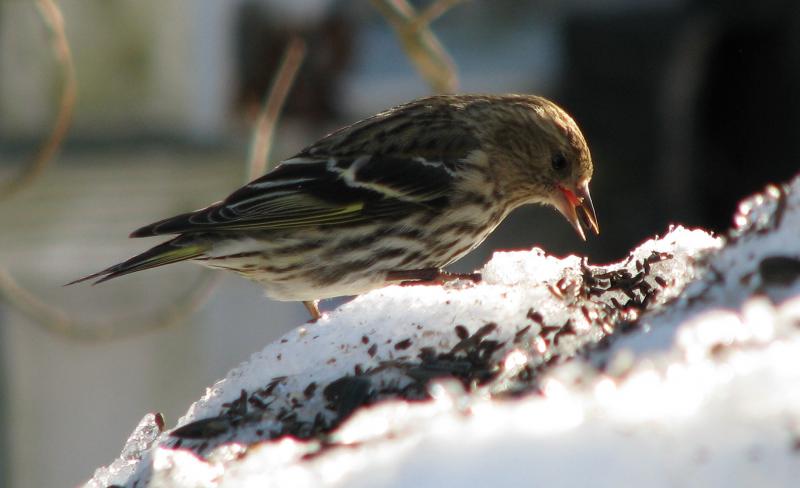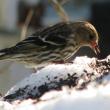Election Day flocks
Just yesterday we heard the whiney “shree” sounds of pine siskins in our neighborhood and were delighted to find a flock of about 40 descending into the bare branches of a maple a block away. This morning as we stepped out the front door we looked up into the blue sky to see a flock of at least 50 American robins passing high overhead. And as we arrived at our local polling station to cast our vote, there was yet another flock of pine siskins in a yard across the street.
Many animals gather in groups at one time or another for a variety of reasons. In fact, to an outside observer, the gathering of people at the voting station just as the polls opened might have looked like a flock! But spontaneous groups that form, like humans waiting to vote, are a bit different from the flock of pine siskins in the backyard or the flock of common eiders bobbing about on the water at Ocean Point.
Groups of birds can form at major food sources, as we often see at feeders or dump sites. We well remember seeing over a hundred yellow warblers, a species that normally occurs together only in small numbers, congregating around one of the only sources of fresh water on the very dry island of Bonaire many years ago. In these cases, most of the birds associate with each other very temporarily and because the resource that they need (food or water) is limited and found in only a few spots in the area.
The flock of pine siskins we saw this morning is instead more likely to be made up of individuals that have stayed together for an extended period. They are staying with each other probably for a host of reasons.
One of the theories behind why animals form these longer-lasting associations, like flocks in birds and herds in mammals, is that an individual in a flock has a lower likelihood of being singled out and attacked by a predator. In essence, one can “hide” in the larger group. It’s a bit like the classic scene in an action movie when the person being pursued disappears into a massive street crowd so the pursuer can no longer follow their movements among the mass of humans.
Another reason that birds may flock is to take advantage of the fact that within a group, there are more eyes available to detect predators and give warning. A flock of birds can provide more eyes on the look-out for the scattered and sometimes hard-to-find sources of food and water. Inexperienced birds in a flock may do better by being in a flock with older, more experienced birds that may already know of food sources from past years and be better able to recognize danger. In cold climates, roosting with a flock can also allow the sharing of body heat to increase an individual’s odds of making it through the night.
In the coming weeks and months, keep an eye out for flocks coming and going as they respond to coming changes in weather and the challenges that can bring — for birds and for humans, too!
Event Date
Address
United States

























